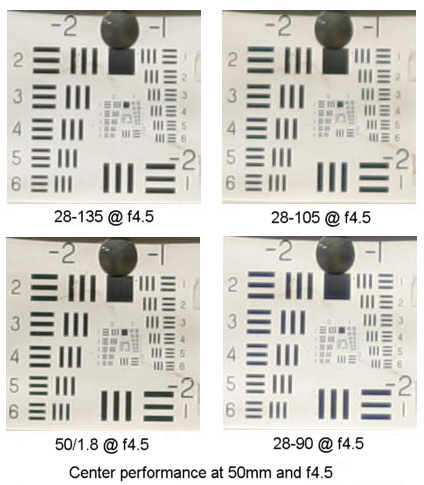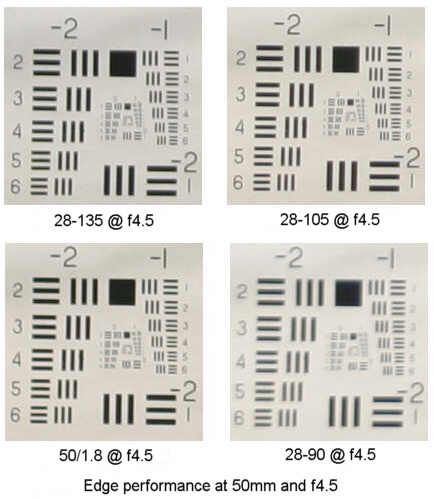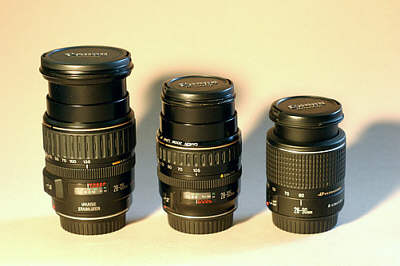
|
Canon's EF 28-90/105/135 zoom lensesBy Bob Atkins Canon currently have a number of choices for a general purpose zoom lens. Three of the choices are the 28-90/4-5.6 (USM and non-USM), the 28-105/3.5-4.5 USM and the 28-135/3.5-5.6 IS USM and these span the range from around $100 to $400 - so one of these lenses will probably fit your budget! There's also a 28-80/3.5-5.6 lens which I think is out of production(?) and a 28-105/4-5.6 USM (not to be confused with the 28-105/3.5-4.5 USM). Both are "low end" lenses, comparable to the 28-90/4-5.6 USM, but since I have access to neither, I didn't test them! The Lenses
Left to right: 28-135/3.5-5.6 IS USM; 28-105/3.5-4.5 USM; 28-90/4-5.6
USM EF28-90/4-5.6 (USM) - Price class $125This is Canon's low end basic zoom, often sold in "kits" with an EOS body. It's small, it's light and it's cheap. The construction uses lightweight plastic, even for the lens mount - though the optics are all glass. The lens feels fairly flimsy and I don't think I'd want to try drop testing it!. Though it has manual focus, it has no manual focus ring. To focus manually you rotate the front end of the lens barrel. Focusing is loose and undamped and quite sensitive to small rotations of the barrel. In addition the barrel wobbles up and down quite a bit, which isn't a good sign for optical alignment! There is no distance scale (hence no IR focus markings). A basic lens at a low price. Though the lens is available in USM and MM (Micro Motor) versions, this isn't the ring USM motor with FTM (full time manual focus). There really isn't a significant difference between the MM version and the USM version, though Canon claim the USM version is quieter and focuses faster. It probably is and does, though I'm sure the difference isn't very significant. EF28-105/3.5-4.5 USM - Price class $250This lens is a huge step up. It's solidly constructed with a metal lens mount. It has a ring USM motor with full time manual focus, a distance scale and IR focusing marks. It's a little bigger, a little heavier and about twice as expensive as the 28-90, but it's a much better constructed lens. Manual focus is smooth, well damped and geared so that fine adjustments can be made, as you would expect from a ring motor FTM USM based lens. The current version is the "II" model, though it is optically identical to the original model which was tested here. The differences are mainly cosmetic. Note: there is also an EF28-105/4-5.6 USM lens. This is a cheaper lens (around $160), with a plastic lens mount. Don't confuse the two. If you see a 28-105 at around $160, you're not getting a bargin on the 28-105/3.5-4.5 (II), you're most likely getting the inferior, cheaper lens. EF28-135/3.5-5.6 IS USM - Price class $450This lens is significantly larger and heavier than the 28-105 but is of a similar solid construction with a metal lens mount, ring USM motor, FTM, distance scale and IR focusing marks. It also has image stabilization which allows it to be hand held at shutter speeds about two stops slower than would otherwise be possible and still get sharp images. It costs about twice as much as the 28-105. It takes a significantly larger filter than the other two lenses (67mm vs. 58mm). Manual focus is smooth, well damped and geared so that fine adjustments can be made, as you would expect from a ring motor FTM USM based lens. This lens uses one aspheric element (neither of the other lenses tested have aspheric elements) which may contribute to better performance - at least that's the idea behind using aspheric elements Technical Data
The Tests
One problem with testing zooms, and comparing three different zooms, is that you can generate huge amounts of data. You can test at 5 different focal length settings at 6 different apertures at both center and edge for each of the lenses. That's 180 different images to compare. I'm not going to present 180 images here or it would take all day to download the page, not to mention using up most of my bandwith allocation. Instead I'm going to draw conclusions based on my own assessment of a large set of images and present my observations. Focusing is the most critical issue in any lens test. If you miss focus even slightly you can draw incorrect conclusions about lens performance. You can't just blindly assume that AF works perfectly every time with every lens. Usually it does, but this is a lens test, not an AF test. For these tests the correspondence between autofocus and manual focus was checked. Manual focus was assisted by the use of the Canon Viewfinder Magnifier. Focus bracketing was used to make sure that the viewfinder screen gave an accurate indication of the final image (it did!). 28mm testsWide open at 28mm and looking in the center of the frame, it's evident that while all three leses show similar resolution, the 28-135 has slightly higher contrast and lower flare. Stopping down to f9 the center performance of all three lenses became closer, in fact it was hard to pick between them. Looking at the corners of the image, it's clear that both wide open and stopped down to f9 the lower cost 28-90 lens showed lower sharpness and contrast than the other. While the 28-135 and 28-105 were pretty similar, I'd give a very slight edge to the 28-135. 50mm testsLooking at the center performance wide open there is no big difference in resolution, however it's evident that the 28-90 lens shows lower contrast. Again by a very slight margin the 28-135 edges out the 28-105. When stopped down to f9, all three lenses looked quite similar. Edge performance followed the same trend, wide open the 28-90 showed lower contrast and the 28-135 looked very slightly better than the 28-105. Again, stopped down edge performance was very similar from all three lenses. 50mm - how about a prime?Note: these images are 100% crops from the original much larger image The question always seem to come up whether zooms are as good as primes. Well lets look at the EF50/1.8 prime and see how it stacks up against the zooms at 50mm. To make this fair, all the lenses were set to f4.5, which is more or less wide open for the zooms, but more than 3 stops closed for the 50mm prime. 
In the center of the image, the 50mm lens at f4.5 had an edge. Contrast was slightly better than the 28-135 and 28-105 and significantly better than the 28-90. Resolution was't very different though.  At the edge there wasn't too much difference between the prime and the 28-135 and 28-105 zooms, but the 28-90 clearly suffered pretty badly at the edge. Is the prime significantly better then the two more expensive zooms - In my opinion, no , it's not. It is slightly better though, and it is three stops faster for those times when you really need speed - and 3 stops for $80 is a pretty good deal! 90mm testsLooking at the center of the image, again it's evident that the 29-90 has the lowest contrast and resolution wide open, and this time stopping down doesn't really help much. The other two lenses are fairly equal, with the 28-135 perhaps showing just slightly better contrast, though it's a tough call. Edge performance at 90mm clearly shows that the 28-90 lags behind the other two lenses wide open. Both contrast and resolution are low. It improves when stopped down but still isn't as sharp as the 28-105 or 28-135. It's tough to see much difference between the two better lenses. If there is one it's too small to be of any significance. What about the lenses you didn't testWell, I didn't test them because I don't have access to them, but in the spirit of photo.net I'll still make a few comments! There is a 28-80 low end zoom which was, I think, replaced by the 28-90. Plastic construction, no distance scales etc.etc. From what I've read and from my general experience with Canon lenses, I'd assume it's pretty similar to the 28-90. There is a current 28-105/4-5.6 USM which is NOT, repeat, NOT to be confused with the 28-105/3.5-4.5 USM tested here. The 4-5.6 version is another low end plastic lens in the same family as the 28-90. Since it's only about $50 cheaper than the 3.5-4.5, I can see no earthly reason to consider buying one. There is a 24-85/3.5-4.5 USM which is priced between the 28-105/3.5-4.5 and the 28-135/3.5-5.6. It's a mid range lens like the other two, with full time manual focus, a ring USM, distance scales etc. It has a good reputation and is certainly an alternative if you are prepared to trade off the telephoto end for the wide-angle end of the range. There is a 28-200/3.5-5.6. I'd be very interested in testing this lens, but I think it would be most fair to test it against 3rd party lenses of similar zoom range. Then there are the high end "L" series lenses of which the 24-70/2.8L USM is the current production version. However at $1400, it's not really a lens most consumers will consider and it's not one that's in my camera bag, so a test on that lens will have to wait until someone gives one to me... Conclusions (about the lenses I DID test)The 28-90 low end lens does fairly well. True, it's not generally as good as the more expensive lenses when used wide open, particularly at 90mm, but it does quite well when stopped down. Edge performance isn't quite so good as the better lenses, but the difference is pretty small, especially stopped down at shorter focal lengths. All in all an OK performance and certainly capable of yielding decent quality small prints and maybe even the occasional 8x10. If you're looking for the smallest, lightest, cheapest lens and you use it mostly stopped down and at the short-to-mid zoom range, then it could be a reasonable choice. It's not a very sturdy lens and the ergonomics aren't great either (no separate focus ring, no distance scale, no full time manual focus, no ring USM), but it's "only" around $125 and these days $125 doesn't buy you much more than this in an autofocus lens. I don't think I'd go so far as to actually recommend this lens, but if you have one I wouldn't recommend throwing it away either! The 28-105 is a very nice lens to use, it's well built and has good optics, certainly better than the 28-90. It has a ring type USM motor with full time manual focus. plus it has a distance scale and IR focusing marks. At under $250 I think it's a good deal and a significantly better lens than the 28-90 as long as you don't mind the slightly larger size and increased weight. You also get a longer reach (105 vs. 90), which can be useful. I've owned this lens for many years and I've never been disappointed with it. I can certainly recommend this lens to anyone wanting good performance at a reasonable price. The 28-135 is clearly the winner from an optical and functional viewpoint. Optically it's as good as or slightly better than the 28-105 at equivalent settings, plus it has an extra 30mm of reach. Like the 28-105 it has a ring USM motor, full time manual focus, distance scales and IR focusing marks. The IS function really works and allows you to handhold at 1/8s at 28mm, whereas without IS you might need 1/30s for sharp images. If you're stuck without a tripod this could be the difference between getting a shot and losing it. The downside of the lens is its extra cost (about $180 more than the 28-105) and its significantly increased size and weight, as well as the need for a larger (and more expensive) filter (72mm vs. 58mm). If size weight and cost aren't an issue, it's the better lens. I got this lens in a deal where I bought a camera and this lens came with it. I had intended to sell the lens, but after using it for a while I'm quite reluctant to part with it! The IS feature is really nice... What would I chose if I had no lens in this range? If my funds were limited I wouldn't totally dismiss the 28-90, though I think if at all possible I'd skip the beer and pizza for a month, save up another $120 or so and go for the 28-105. It's a significantly better lens and well worth the extra cost. The major difference between the 28-105 and 28-135 are in terms of functionality (IS and 135mm vs. 105mm), not so much in optical quality - though I would say the 28-135 does have a slight edge, especially when used wide open. Which lens you buy between these two is very much a personal decision depending mainly on just how much you think you'll need the IS function and whether you think you'll use the extra range. Be warned though, the IS function is seductive and once you've used it it's hard to give it up!
Where to Buy?Try Amazon.com for very good prices and easy ordering.
© Copyright Bob Atkins All Rights Reserved |
||||||||||||||||||||||||||||||||||
